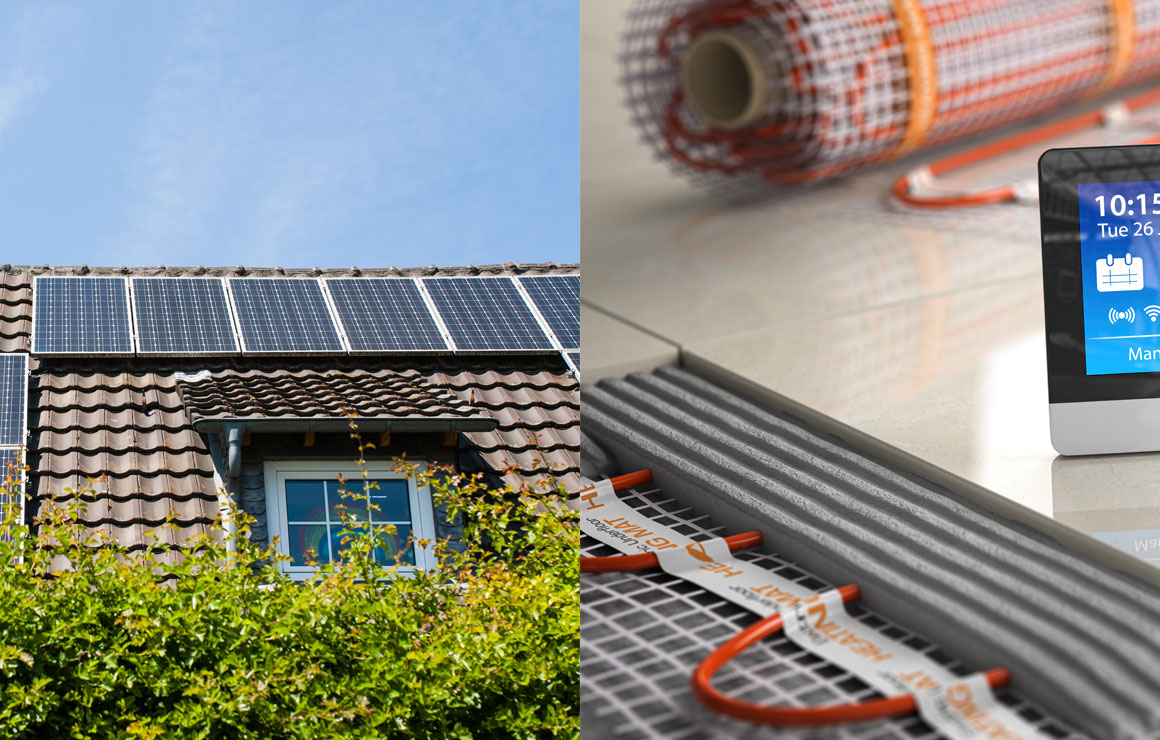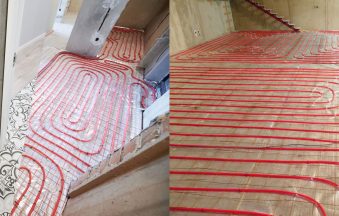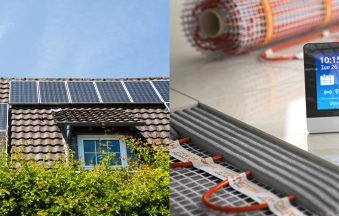Does Underfloor Heating Work Well with Renewable Energy Sources?
In today’s eco-conscious world, homeowners are increasingly looking for heating solutions that not only deliver comfort but also contribute to a sustainable lifestyle. Underfloor heating has long been celebrated for its efficient, even warmth and sleek design – and when paired with renewable energy sources, it becomes a powerhouse for sustainable home heating. In this post, we’ll explore how underfloor heating works, its compatibility with renewable energy, and why this synergy is a game changer for energy efficiency and eco-friendly living.
What Is Underfloor Heating?
Underfloor heating is an innovative heating system installed beneath your floor surface to provide gentle, radiant warmth throughout your home. There are two primary types:
Hydronic (Water-Based) Underfloor Heating:
This system circulates warm water through pipes laid beneath the floor. It works efficiently at lower temperatures, making it highly compatible with renewable heat sources like solar thermal systems and geothermal heat pumps.Electric Underfloor Heating:
Using electric cables or mats installed under the flooring, this system converts electricity into heat. It is often easier to retrofit in existing homes and pairs seamlessly with renewable energy systems when powered by green electricity.
Both systems offer advantages such as even heat distribution, improved comfort, and the elimination of bulky radiators – making them an attractive choice for modern, energy-efficient homes.
Renewable Energy Sources for Home Heating
Renewable energy is transforming the way we power our homes. Here are the most common renewable sources that can be integrated with underfloor heating systems:
Solar Power:
Photovoltaic (PV) panels convert sunlight into electricity, which can power electric underfloor heating systems. Additionally, solar thermal panels can preheat water for hydronic systems, reducing reliance on the grid.Wind Energy:
Wind turbines generate clean electricity that can be used to operate underfloor heating systems, particularly in regions with consistent wind patterns.Geothermal Energy:
Geothermal heat pumps harness the Earth’s stable underground temperatures to heat water or air. They are particularly effective in powering hydronic underfloor heating systems, delivering reliable, low-temperature heat even in colder climates.Biomass Energy:
Biomass boilers use organic materials, like wood pellets, to produce heat. When combined with hydronic underfloor heating, biomass can provide an efficient and sustainable heating solution.
By tapping into these renewable energy sources, homeowners can reduce their carbon footprint and enjoy long-term energy savings.
The Synergy Between Underfloor Heating and Renewable Energy
Efficient Heat Distribution at Lower Temperatures
One of the key advantages of underfloor heating is its ability to operate effectively at lower temperatures compared to traditional radiators. This means that:
- Hydronic systems can circulate water heated by renewable sources without needing to reach the high temperatures required by conventional boilers.
- Electric systems can deliver a comfortable warmth even when powered by electricity generated from renewable sources.
Lower operating temperatures translate to higher efficiency, reducing energy consumption and lowering energy bills while maximising the benefits of renewable energy.
Seamless Integration with Modern Technologies
Underfloor heating systems can easily be integrated with smart home technologies. Advanced thermostats and zoning controls allow homeowners to fine-tune their heating schedules, ensuring that renewable energy is used as efficiently as possible. For instance:
- Smart Thermostats: Automatically adjust the temperature based on occupancy and weather conditions, ensuring that energy from renewable sources is used optimally.
- Zoning Systems: Allow different parts of the home to be heated separately, reducing waste and maximising comfort.
Environmental Impact and Cost Savings
When underfloor heating is paired with renewable energy sources, the environmental benefits multiply:
- Reduced Carbon Footprint: By relying on clean energy, homeowners can significantly cut down on greenhouse gas emissions.
- Long-Term Savings: Although the initial installation cost may be higher, the combination of efficient heating and renewable energy can lead to substantial savings over time.
- Enhanced Indoor Comfort: Even heat distribution creates a more comfortable living environment, minimising cold spots and drafts that are common with radiator-based systems.
Installation Considerations and Best Practices
Professional Assessment
Before installing an underfloor heating system, it’s essential to have a professional assess your home’s insulation, floor structure, and overall heating requirements. This ensures that the system is tailored to maximise both comfort and efficiency.
Compatibility with Flooring
Not all flooring materials are created equal when it comes to underfloor heating. Materials with high thermal conductivity – such as tile, engineered wood, and certain luxury vinyl tiles (LVT) – allow heat to pass through efficiently, enhancing the system’s performance.
Integration with Renewable Energy Systems
To fully leverage renewable energy, consider these key factors:
- Energy Storage Solutions: Battery storage systems can capture excess solar or wind energy for use during periods when renewable generation is low.
- Hybrid Systems: In some cases, combining renewable sources (like solar PV with a geothermal heat pump) can provide a more stable and reliable energy supply.
- Smart Grid Compatibility: Ensure that your heating system can interface with smart grid technologies to take advantage of dynamic pricing and renewable energy surpluses.
Real-World Success Stories
Many homeowners have already embraced the combination of underfloor heating and renewable energy, and their experiences offer compelling evidence of the system’s effectiveness:
- Eco-Efficient Homes: In several cases, houses equipped with hydronic underfloor heating powered by geothermal energy have seen significant reductions in energy bills and carbon emissions.
- Solar-Powered Comfort: Homeowners who have installed solar panels to power their electric underfloor heating systems report not only a noticeable increase in comfort but also a rewarding decrease in energy costs – especially during sunny months.
- Integrated Smart Systems: Properties that integrate smart thermostats with underfloor heating and renewable energy sources enjoy precise temperature control, ensuring that every watt of green energy is used effectively.
These success stories highlight that underfloor heating is not just a luxury – it’s a smart, sustainable investment in the future of home comfort and environmental responsibility.
Overcoming Common Challenges
While the benefits are clear, there are a few challenges to consider when combining underfloor heating with renewable energy:
- Initial Investment: The upfront cost of installing underfloor heating and renewable energy systems (such as solar panels or geothermal units) can be high. However, government incentives, rebates, and long-term energy savings often help offset these costs.
- System Design: Integrating multiple systems requires careful planning. It’s important to work with experienced installers and energy consultants to ensure that all components are compatible and optimised for efficiency.
- Maintenance and Monitoring: Regular maintenance is key to ensuring that both the heating system and the renewable energy components continue to operate efficiently. Smart monitoring systems can help detect issues early and keep the system running smoothly.
By addressing these challenges head-on with proper planning and professional support, homeowners can enjoy a reliable, energy-efficient heating solution that stands the test of time.
Conclusion
Underfloor heating paired with renewable energy sources offers a compelling solution for the modern, eco-conscious homeowner. Its ability to provide even, comfortable heat at lower operating temperatures makes it an ideal partner for renewable technologies such as solar, wind, geothermal, and biomass. The benefits are clear: reduced carbon emissions, long-term cost savings, and enhanced indoor comfort – all without the need for bulky radiators.
As we move toward a greener future, the integration of underfloor heating with renewable energy systems is not just a trend – it’s a smart investment in sustainable living. Whether you’re planning a new build or retrofitting your existing home, consider the synergy of these technologies to create a warm, energy-efficient, and environmentally friendly space.
Ready to take the next step toward sustainable heating? Contact a certified installer today to explore how underfloor heating combined with renewable energy can transform your home into an eco-friendly haven.






